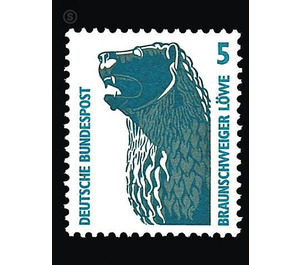Postage stamps: Places of interest - Germany / Federal Republic of Germany 1990 - 5 Pfennig
Theme: Art & Culture
| Country | Germany / Federal Republic of Germany |
| Issue Date | 1990 |
| Face Value | 5.00 |
| Color | green white blue |
| Perforation | K 14 |
| Printing Type | indirect 2-color letterpress |
| Stamp Type | Postage stamp |
| Item Type | Stamp |
| Chronological Issue Number | 1321 |
| Chronological Chapter | GER-BRD |
| SID | 699729 |
| In 63 Wishlists | |
The great Guelph Duke Henry the Lion, who has shaped the urban development of Braunschweig and his cityscape until today, had the Braunschweig Lion built. According to the testimony of Albert of Stade this happened in 1166. The lion is the heraldic animal of the Guelphs. He embodies the sovereign power of the Welfish ruler and demonstrates that Duke Henry did not lead his surname "the lion" in vain. At the same time, the lion is the expression of the highest jurisdiction of the Welfs in the city of Brunswick. The Brunswick lion cast in bronze was gilded in former times. The proud lion figure rises on a high stone base. The taut body, the long, sweeping tail and the powerful head with a splendidly stylized mane express the tension and strength of the king of the animals. His gaze is directed to the east, where one of the most powerful enemies of the Guelph Duke, Albrecht the Bear, opposes the expansion of the German Empire. The Braunschweiger lion is most likely originated in Braunschweig itself as a work of outstanding artists and craftsmen. It is the first monumental free sculpture of the Middle Ages and to this day one of the most impressive Romanesque sculptures. With the Hildesheim Erztüren and the Hildesheim Christussäule it belongs to the very large Lower Saxon and German works of the Erzgießerei. The Braunschweiger Löwe dominates the Burgplatz in Braunschweig in an impressive frame of historic buildings: the former residence of Henry the Lion, Dankwarderode Castle, built by Henry the Lion in the years 1173 to 1195 as a three-aisled basilica, the Viewegschen publishing house, now the Braunschweig Provincial Museum houses, the ducal ministerial court of the family von Veltheim, now the seat of the Chamber of Crafts, and the Huneborstelschen house from 1124, the so-called Gildehaus. In this environment of the Braunschweiger Burgplatz with its medieval ground plan, the Braunschweiger lion has exercised an unbroken fascination and attraction over the people over the centuries. The citizens of Braunschweig hang with particular affection on the monument as a reminder of the great past of their hometown. In the Westphalian period they prevented rumors of plans by the then foreign government to melt down the Brunswick lion. During the Second World War, the lion was brought to safety in the old Goslar silver mine of Rammelsberg and escaped destruction. Even today he still impresses the post-war generations with the magnificent monumentality of the heraldic power of his formal language. (Text: The Lower Saxony Minister of Economics, Technology and Transport, Hannover)


